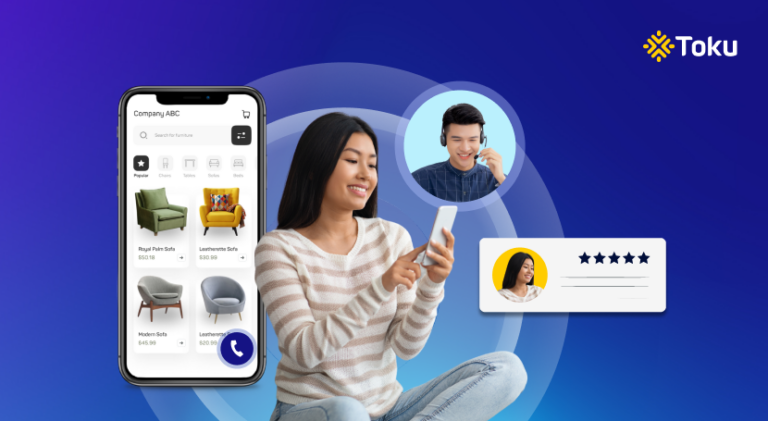Frost & Sullivan’s Entrepreneurial Company of the Year Award recognised Toku as the best up-and-coming, potentially disruptive market participant in the Southeast Asia CCaaS market.
After almost two years of adapting, transforming, and responding to unprecedented change, enterprises are now facing a new normal in customer relations. The reality is that consumers have embraced the ease and convenience of engaging online, yet still demand a highly personalised customer experience rich in human connections and empathy.
To meet this highly complex challenge, businesses are turning to omnichannel strategies that meet customers where they’re at in terms of contextual relevance whilst maintaining a digital-first focus.
At Toku, we take customer experience seriously.
Which is why we’re psyched to be part of Freshworks’ webinar on CX2022: The age of digital-first experiences. Our CEO, Thomas Laboulle participated in this event, and gave his thoughts on improving customer experience in APAC.
Here are 5 quick takeaways:
1. ‘Want it now’ customers dictate the terms of your customer experience
According to a Freshworks survey of over 4,500 businesses, and their analysis of over 107 million customer service interactions, speed has the highest impact on CSAT (Customer Satisfaction).
This can translate to improving your customer support’s response rate. After all, 83% of customers in APAC say they expect to engage with someone immediately when contacting a company.
Speed can also mean improving on your ‘self-service options’ – like with an IVR menu – for customers, that empowers them to resolve their problems immediately on their own. As you can imagine, seamless and intuitive customer experience that facilitates self-service reduces the need for lengthy customer service calls or interactions.
On customer interactions, Toku CEO, Thomas Laboulle also added, “On the hybrid working side of the coin, companies are requesting better tools to empower their agents and supervisors with more visibility during a customer interaction.”
This in turn is helping them to deliver a smooth customer experience to “want it now” customers who aren’t going to stick around and repeat details that they’ve already given in a previous interaction with customer support.
2. Seamless omnichannel experiences trump physical-digital patchwork
Technology can drive experiences that tie together both digital and physical channels to offer a frictionless customer journey with less need for customers to repeat details as they engage with multiple channels. However, omnichannel seamlessness doesn’t necessarily imply an enterprise needs “all” the channels on hand.
“We notice that many brands are adding a list of channels and have an approach that ‘more is better’, but that’s not necessarily the case. It’s more important to see what channels add the most value to your customers.”
Thomas Laboulle emphasised, “You need to understand what channels your audience is looking for and why, and understand the use case. We notice that many brands are adding a list of channels and have an approach that ‘more is better’, but that’s not necessarily the case. It’s more important to see what channels add the most value to your customers. It’s also better to start with a small number of channels first and progressively add on as you see fit, rather than start with several channels that you then have to deactivate later on.”

Get monthly nuggets of wisdom for all things customer experience in your inbox
3. Balancing messaging and phone support
Messaging is more popular than ever and organisations are eager to add this channel to their operations. However, you need to balance this with voice channel communications.
On average, the cost of phone calls as opposed to a messaging interaction could appear much higher. This implies that employing a messaging strategy in your business can save on costs. However because having the human element in interactions is still vital, a business needs to carefully evaluate the value of messaging vs customer call.
Very often, businesses can see higher ROI from customer interactions over phone call as opposed to messaging because customers tend to prefer the human-to-human voice aspect of a phone call.
For instance, according to Thomas, “a challenge we see sometimes in larger organisations an insufficient assessment as to why they are incorporating messaging. You need to ensure management’s goals are aligned with what’s best for the organisation and for the customer satisfaction. This is why understanding your customers’ actual channel preferences is so crucial. Cost cannot be the sole driver of the decision process of implementing messaging for omnichannel. Ultimately, messaging does have several benefits but it is not a silver bullet for any enterprise.”
4. Empower your agents to drive customer delight
However, there are plenty of opportunities to empower the agents upstream of the customer call. If you’re planning ahead and ensuring the customer journey itself is as seamless as possible through messaging, chatbots, etc., this lowers the potential customer frustration levels even before they call your agents.
Thomas emphasised, “The more an organisation can remove potential friction points, by selecting the right channel mix, selecting the right questions in a chatbot or IVR, etc., the more you will empower your agents, and delight the customers.”
On top of this, ensuring that your agents have full visibility over all customer details such as transaction and communication history across channels will empower them to paint a fuller picture of the client and deliver a more frictionless experience.
5. Impact of automation and prediction on customer experience
Automation tools such as chatbots have become increasingly popular for repetitive tasks in the customer journey.
For example, they can easily provide quick answers to frequently asked questions at scale, do it 24/7. Hence, they are a great way to liberate your agents to handle more complex, value-added queries.
When it comes to prediction, this really is the next step after automation, in creating truly frictionless customer experiences.
For example, Thomas illustrated, “Integrations allow you to analyse purchase history, previous customer complaints, sentiment analysis, which in turn allows you to predict and plan the most suitable journey for the customer. Using all this information to decide if this customer needs a more experienced agent or a simple chatbot option to answer their query is incredibly useful to any business looking to streamline their operations and customer experience.”
Conclusion
Customer expectations are higher than ever and word of mouth travels fast! With a strong customer experience (CX) strategy, we believe that any business can truly differentiate themselves in a crowded market, enjoy higher retention and grow revenue.
 Ana Castrillon
Ana Castrillon 

 V K Sanjeed
V K Sanjeed 
 Nora Huin
Nora Huin 